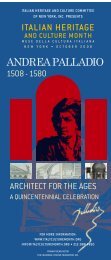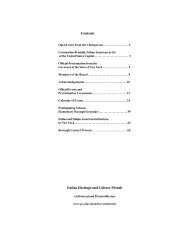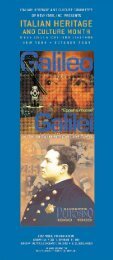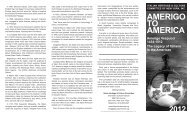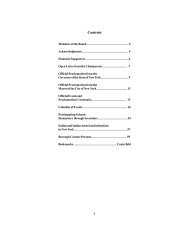Brochure - Italy Culture Month
Brochure - Italy Culture Month
Brochure - Italy Culture Month
You also want an ePaper? Increase the reach of your titles
YUMPU automatically turns print PDFs into web optimized ePapers that Google loves.
About 1873 a certain Bill Carroll from Boston,<br />
who had news about Meucci's invention, asked<br />
him to construct a “telephone for scuba divers.”<br />
This device should allow divers to communicate<br />
with people on the surface.<br />
On December 28, 1874, Meucci's caveat<br />
expired. When Bell secured his own patent in<br />
1876, Meucci took Bell to court in order to state<br />
his priority on the ground of patent infringement.<br />
Being too poor to hire a legal team, Meucci was<br />
defended only by lawyer Joe Melli, an orphan<br />
whom Meucci treated as a son.<br />
While the trial “The U.S. Government Versus<br />
Alexander Graham Bell” was going on, the Bell<br />
telephone company set up another trial “The U.S.<br />
Government Versus Antonio Meucci.”<br />
The trial<br />
Meucci's electromagnetic telephone was<br />
described in L'Eco d'Italia of New York at the<br />
beginning of 1861, though all issues of the 1861-<br />
1863 period are not available in the major<br />
libraries of the United States. They appear to<br />
have been destroyed in a fire, so that Antonio<br />
Meucci had to swear in court what he remembered<br />
he wrote in the newspaper.<br />
One of the most important pieces of evidence<br />
brought up in the trial was Antonio Meucci's<br />
“Memorandum Book.” In this sort of agenda,<br />
produced by Rider & Clark, Antonio Meucci<br />
noted drawings and records since 1862 up to<br />
1882. In the trial, Antonio Meucci was accused of<br />
having produced records after Alexander Graham<br />
Bell's invention and back-dated them. As a proof,<br />
the prosecutor produced the fact that Rider &<br />
Clark was founded only in 1863. In the trial,<br />
Antonio Meucci said that William E. Rider himself,<br />
one of the owners, had given him a copy of the<br />
memorandum book in 1862. But he was not<br />
believed. While the trial “The U.S. Government<br />
Versus Alexander Graham Bell” was going on, the<br />
Bell telephone company set up another trial “The<br />
U.S. Government Versus Antonio Meucci.”<br />
On January 13th 1887 the Government of the<br />
United States moves to Alexander Graham Bell on<br />
the grounds of fraud and misrepresentation.<br />
Bell Telephone Company obtained reason in the<br />
trial “The U.S. Government Versus Antonio<br />
Meucci” by a sentence on July 19th 1887 by<br />
judge William J. Wallace, who ruled that Meucci<br />
had a mechanical and not an electrical telephone.<br />
According to Wallace's ruling, “The experiments<br />
and invention of one Antonio Meucci, relating to<br />
the transmission of speech by an electrical apparatus,<br />
for which invention a caveat was filed in the<br />
United States patent-office, December 28, 1871,<br />
renewed in December, 1882, and again in<br />
December, 1883, do not contain any such elements<br />
of an electric speaking telephone as would<br />
give the same priority over or interfere with the<br />
said Bell patent.<br />
The application does not describe any of the elements,<br />
of an electric speaking telephone. Its<br />
opening statement refutes the possibility that<br />
Meucci understood the principle of that invention.<br />
His speaking telegraph would never have<br />
been offered to the public as an invention if he<br />
had not been led by his necessities to trade on the<br />
credulity of his friends; that he intended to induce<br />
the three persons of small means and little business<br />
experience, who became his associates<br />
under the agreement of December 12th, 1871, to<br />
invest in an invention which he would not offer to<br />
men like Ryder and Craig; and that this was done<br />
in the hope of obtaining such loans and assistance<br />
from them as he would temporarily<br />
require.” The judge was scathing in his criticism<br />
of Meucci's claims and his behavior, and concluded<br />
that Meucci was deliberately involved in<br />
attempts to defraud investors.<br />
In fact, when the Bell Telephone Company sued<br />
Meucci's backers for patent infringement, their<br />
defense was that they could not have infringed<br />
on Bell's patent, since Meucci's “telephone” had<br />
never even worked.<br />
Meucci died before the Court reached a verdict<br />
for his own case, which was closed at the death of<br />
the prosecutor.<br />
Historical debate<br />
The question of whether Bell was the true inventor<br />
of the telephone is perhaps the single most litigated<br />
fact in U.S. history, and the Bell patents<br />
were defended in some 600 cases. Meucci was a<br />
defendant in American Bell Telephone Co. V.<br />
Globe Telephone Co. and others.<br />
ITALIAN HERITAGE &<br />
CULTURE MONTH COMMITTEE<br />
The Italian Heritage & <strong>Culture</strong> <strong>Month</strong><br />
Committee For more than thirty years<br />
the committee has organized events,<br />
concerts, exhibits and lectures, celebrating<br />
Italian culture in New York, the<br />
largest Italian city outside of <strong>Italy</strong>. Each<br />
year a theme representative of the history<br />
and culture of <strong>Italy</strong> and Italian<br />
Americans is highlighted. The committee<br />
promotes Italian culture by focusing on<br />
schools and taking a leadership role in<br />
promoting <strong>Italy</strong> and its cultural contributions.<br />
The committee web site,<br />
www.italyculturemonth.org, is the place<br />
to go for anything Italian: language,<br />
newspapers, culture, travel and many<br />
other resources on <strong>Italy</strong> and Italian culture.<br />
Mailing Address:<br />
Italian Heritage & <strong>Culture</strong> <strong>Month</strong><br />
Committee<br />
C/O Italian Cultural Institute<br />
686 Park Avenue<br />
New York, New York 10021<br />
Telephone: (212) 642-2094<br />
Web address:<br />
www.italyculturemonth.org<br />
Garibaldi Meucci Museum<br />
Telephone: (718) 442-1608<br />
www.garibaldimeuccimuseum.org<br />
© 2008 1/11/08<br />
ITALIAN<br />
HERITAGE & CULTURE MONTH<br />
COMMITTEE OF NEW YORK, INC.<br />
ANTONIO<br />
MEUCCI<br />
1808-2008<br />
theTRUE inventor<br />
of the telephone<br />
Staten Island, New York
Antonio Meucci<br />
(April 13, 1808 - October 18, 1889)<br />
Antonio Meucci (April 13,<br />
1808 - October 18, 1889)<br />
was an Italian inventor. He<br />
developed a form of voice<br />
communication apparatus<br />
in 1857 and has long had<br />
champions arguing that he<br />
should be credited with the<br />
invention of the telephone.<br />
Meucci set up a voice communication<br />
link in his Staten<br />
Island home that connected<br />
the basement with the second<br />
floor. He was unable to<br />
raise sufficient funds to pay his way through the<br />
patent application. He filed a patent caveat in<br />
1871, which expired in 1874. In 1876, Alexander<br />
Graham Bell patented the electromagnetic transmission<br />
of vocal sound by ondulatory electric current.<br />
There is also held a belief that the reason Bell got<br />
the idea was due to the fact that Meucci's wife<br />
sold Meucci's documents and projects for a mere<br />
$6 while he was suffering a fever and unable to<br />
leave bed.<br />
The United States House of Representatives recognized<br />
that legally, “If Meucci had been able to<br />
pay the $10 fee to maintain the caveat after 1874,<br />
no patent could have been issued to Bell”; then<br />
Meucci would have been considered the inventor<br />
of the telephone.<br />
On January 13th, 1887 the Government of the<br />
United States moved to annul the patent issued to<br />
Bell on the grounds of fraud and misrepresentation.<br />
The prosecuting attorney was the Hon.<br />
George M. Stearns under the direction of the<br />
Solicitor General George A. Jenks.<br />
On July 19th 1887, the judge William J. Wallace<br />
(Circuit Court, S. D. New York.) concluded: “The<br />
experiments and invention of Antonio Meucci,<br />
relating to the transmission of speech by an electrical<br />
apparatus, for which invention a caveat was<br />
filed in the United States patent-office, December<br />
28, 1871, renewed in December, 1882, and again<br />
in December, 1883, do not contain any such elements<br />
of an electric speaking telephone as would<br />
give the same priority over or interfere with the<br />
said Bell patent.”<br />
The United States House of Representatives in its<br />
resolutions HRES 269 IH dated October 17th<br />
2001 and HRES 269 EH dated June 11th 2002<br />
resolved that the life and achievements of<br />
Antonio Meucci should be recognized, and his<br />
work in the invention of the telephone should be<br />
acknowledged.<br />
Biography<br />
Florence, <strong>Italy</strong><br />
Meucci was born in Florence, <strong>Italy</strong>, in 1808. He<br />
studied chemical and mechanical engineering at<br />
the Florence Academy of Fine Arts and later<br />
worked at the Teatro della Pergola in Florence as<br />
a stage technician, assisting Artemio Canovettii.<br />
In 1834 Meucci constructed a kind of acoustic<br />
telephone as a way to communicate between the<br />
stage and control room at the Teatro della<br />
Pergola. This telephone was constructed on the<br />
model of pipe-telephones on ships.<br />
He married costume designer Estere Mochi on<br />
August 7, 1834.<br />
He was alleged to be part of a conspiracy involving<br />
the Italian unification movement in 1833-1834, and<br />
was imprisoned for three months in <strong>Italy</strong>.<br />
Havana, Cuba<br />
In October 1835, Meucci and his wife left<br />
Florence, never to return. They had accepted the<br />
proposal of a Catalan theater manager, don<br />
Francisco Marti y Torrens, and emigrated to the<br />
Americas, stopping first in Cuba, where Meucci<br />
accepted a job at then called Great Tacón Theater<br />
in Havana (at the time, the greatest theater in<br />
America). In Havana he constructed a system for<br />
water purification and reconstructed the Gran<br />
Teatro, which had been almost entirely destroyed<br />
by a hurricane.<br />
In 1848 his contract with the Governor expired.<br />
Meucci was asked by some doctors to work on<br />
Franz Anton Mesmer's therapy system on patients<br />
suffering from rheumatism. In 1849 Meucci<br />
developed a popular method of using electric<br />
shocks to treat illness and subsequently made an<br />
experiment developing a device through which<br />
one could hear inarticulated human voice. He<br />
called this device “telegrafo parlante” (“talking<br />
telegraph.”) In 1850, the third renewal of his<br />
contract with don Francisco Marti y Torrens<br />
expired. Meucci's friendship with the general<br />
Giuseppe Garibaldi made him a suspect citizen in<br />
Cuba. On the other hand, the fame reached by<br />
Samuel F. B. Morse in the United States encouraged<br />
Meucci to make his living through inventions.<br />
Staten Island (NYC), USA<br />
April 13, 1850 Meucci and his wife left Havana to<br />
immigrate to the United States, settling in the<br />
Rosebank area of Staten Island, New York, where<br />
he would live for the remainder of his life. In<br />
Staten Island he helped several countrymen committed<br />
to the Italian unification movement<br />
(“Risorgimento”) and escaped from political persecution.<br />
He invested the substantial capital he<br />
had earned in Cuba in a tallow candle factory (the<br />
first of this kind in America) employing several<br />
Italian exiles. For two years Meucci also hosted in<br />
his cottage his friends the General Giuseppe<br />
Garibaldi and Colonel Paolo Bovi.<br />
Campeggi, who arrived in New York two months<br />
after Meucci. They worked in Meucci's factory. In<br />
1854 Meucci's wife Estere became definitively<br />
invalid because of a serious form of rheumatoid<br />
arthritis, whereas Meucci continued his experiments.<br />
The first electromagnetic telephone<br />
In 1856 Meucci reportedly constructed the first<br />
electromagnetic telephone. He constructed this<br />
as a way to connect his second-floor bedroom to<br />
his basement laboratory, and thus communicate<br />
with his wife. Between 1856 and 1870, Meucci<br />
developed more than 30 different kinds of telephones<br />
on the basis of this prototype. About<br />
1858 the painter Nestore Corradi made a sketch<br />
of Meucci's invention.<br />
In 1860 he began to look for funding and started<br />
in <strong>Italy</strong> looking for Italian capitalists willing to<br />
finance his project. However, military expeditions<br />
led by General Garibaldi in <strong>Italy</strong> had made the<br />
political situation in that country too unstable for<br />
anybody to invest. Then Meucci decided to publish<br />
his invention in the New York Italian-language<br />
newspaper “L'Eco d'Italia.”<br />
Bankruptcy<br />
At the same time, Meucci was led to poverty by<br />
some fraudulent debtors. On November 13, 1861<br />
his cottage in Staten Island was auctioned. The<br />
purchaser allowed the Meuccis to live in the cottage<br />
without paying a rent, but Meucci's private<br />
finances dwindled so that he soon had to live on<br />
public funds and by depending on his friends.<br />
During the years 1859, 1860, and 1861 Meucci<br />
was in close business and social relations with<br />
William E. Ryder, who was interested in his inventions,<br />
paid the expenses of his experiments, and<br />
invested money in Meucci's inventions. Their intimate<br />
relations continued until 1867.<br />
In August 1870, Meucci reportedly obtained<br />
transmission of articulated human voice at the<br />
distance of a mile by using a copper plait as a<br />
conductor, insulated by cotton. He called this<br />
device “telettrofono.”<br />
While he was recovering from injuries that befell<br />
him in a boiler explosion aboard the Staten Island<br />
Ferry, Westfield, Antonio Meucci's financial and<br />
health state was so bad that his wife Estere sold<br />
his drawings and devices to a second-hand dealer<br />
to raise some money.<br />
The caveat<br />
On December 12, 1871 Meucci set up an agreement<br />
with Angelo Zilio Grandi (Secretary of the<br />
Italian Consulate in New York), Angelo Antonio<br />
Tremeschin (entrepreneur), Sereno G. P.<br />
Breguglia Tremeschin (businessman), in order to<br />
constitute the Telettrofono Company. The constitution<br />
was notarized by Angelo Bertolino, a<br />
Notary Public of New York. Their society funded<br />
him $20, whereas $250 was needed in order to<br />
pay for that sort of patent. Meucci then only had<br />
the money to pay for a caveat on December 28,<br />
1871 at the U.S. Patent Office. The caveat is<br />
numbered 3335 titled “Sound Telegraph” and<br />
gives a brief description of the invention.<br />
In summer 1872 Meucci and his friend Angelo<br />
Bertolino went to Edward B. Grant, Vice President<br />
of American District Telegraph Co. of New York,<br />
to ask for help. Meucci asked him for permission<br />
to test his telephone apparatus on the company's<br />
telegraph lines. He gave Grant a description of<br />
his prototype and a copy of his caveat. Up to<br />
1874 Meucci had only enough money to renew<br />
his caveat while looking for funding for a true<br />
patent. After waiting two years, Meucci went to<br />
Grant and asked him to be given back his documents,<br />
but Grant answered he had lost them.



